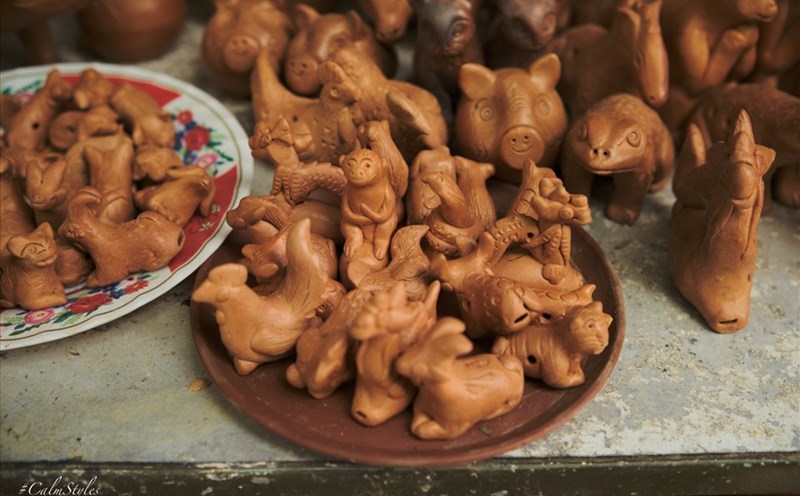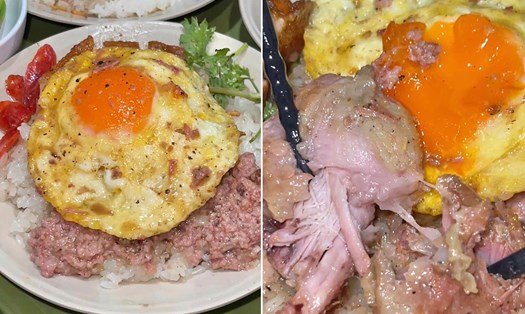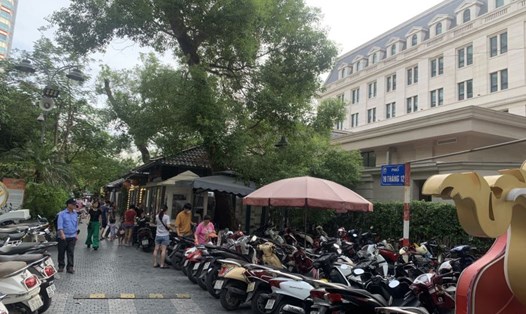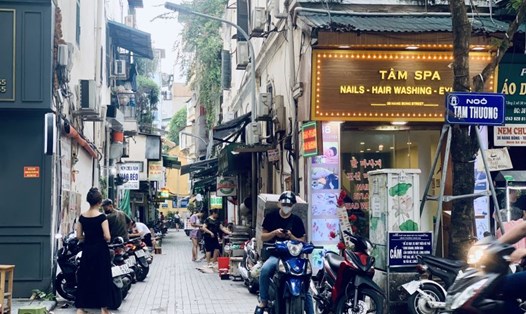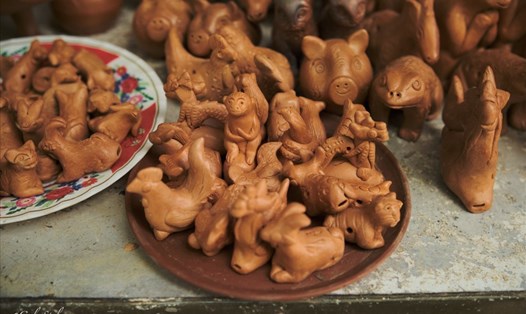A TRANQUILITY
Thanh Ha is an alley, actually a market alley rather than a street. Because Thanh Ha alley is narrow, it is ready to refuse the traffic of cars during the day. It is so narrow that whenever people move through here, they are always in a situation of "shoving shoulders, squeezing wings", leaning left and right as if performing the "Lang Ba Vi Bo" footwork.
Therefore, Thanh Ha is not and should not be a street, just an alley. Also in the past, from the end of the 19th century, the beginning of the 20th century, this alley was called Cu Nau because this place had many people selling brown tubers from boats going up and down, then pressing against the border gate here to unload goods.
Not many people now know what brown root is, but in the past, brown root was very popular. In Hanoi, there is Cu Nau Alley, and in Nam Dinh, there is Hang Nau Street, both of which sell this root. Brown root is used to dye brown fabric, sails for boats... That's why poet Nguyen Binh wrote the poem "Untitled":
"Today, under the ferry, we love each other, looking at each other through the wasp window. Where are you going, where are you going? Brown sail, brown sail, sail...".
What a haunting and wistful brown color, isn’t it? However, now the brown sails are gone, so the rows of brown tubers are no longer there. The name Cu Nau Alley also disappeared, changed to Thanh Ha Alley, and then to Thanh Ha City.
So what does Thanh Ha have to do with Cu Nau? No, because the name Thanh Ha has a much older origin. In the past, this area belonged to Thanh Ha village, Hau Tuc commune, later changed to Dong Xuan commune, Tho Xuong district. Now, it belongs to Dong Xuan ward, Hoan Kiem district.
Thanh Ha village has a communal house which was originally located next to Dong Ha Mon (also known as Quan Chuong Gate). In 1817, Thanh Ha communal house was moved further from the riverbank, to its current location behind house number 77 Hang Chieu street, with the front gate opening onto Ngo Gach street. The communal house worships King Tran Luu, a hero who fought against invaders at the end of the Tran Dynasty.
Thanh Ha Alley is currently located on the main road of Thanh Ha village. When the French first occupied Hanoi, they demolished the earthen wall on the outer wall to build a new road, named Quai Clemenceau, now Tran Nhat Duat Street. A map published in 1890 named the alley Cu Nau.
This alley is about 150m long, starting from the side of O Quan Chuong and ending at Nguyen Thien Thuat Street. Nguyen Thien Thuat Street is also very interesting, connecting Hang Chieu Street to Dong Xuan Market with plenty of food and drinks. When the French reoccupied Hanoi in 1947, the alley was renamed Thanh Ha.
Before being renamed, this alley was associated with the Dong Xuan battle from December 1946 to February 1947, with the battle on February 14, 1947 of the militia, police, soldiers and people of Lien Khu I (Hoan Kiem area). Places such as Thanh Ha and Tu Duong area are forever associated with the spirit of "determination to die for the Fatherland" of Hanoians.
After the destruction of bombs and bullets, Thanh Ha Alley was rebuilt, but the houses here are still as small as before. The alley still contains strange features, such as the entire length of the alley is a market, and most of the houses facing the alley have opened stalls for sale or are rented out to others. This makes Thanh Ha Alley a typical market alley of Hanoi, like Kham Thien Market Alley.
Or in Thanh Ha alley, there are also large constructions such as: Tran Nhat Duat Primary School, Hoi Thong Temple worshiping the Holy Mother Lieu Hanh and Tu Duong Hamlet. People buy and sell right in front of Hoi Thong Temple, but on the first and fifteenth day of the month or on the death anniversary, they all make offerings, hoping for blessings and protection to have a good business.
In the alley there are herringbone alleys that look very narrow when first entering, but after going a few meters deeper you will encounter a space larger than the main alley.
The end of Thanh Ha alley flowing into Nguyen Thien Thuat street has become a crowded commercial area near Bac Qua - Dong Xuan market. The narrower beginning of the street is home to popular shops, still retaining the appearance of the old poor neighborhood. However, the middle of the alley is what makes Thanh Ha alley special: a country market.
ANCIENT COUNTRY MARKET IN THE HEART OF THE OLD TOWN
Thanh Ha Alley is only quiet at night, from around 8:30 pm to 5 am. Otherwise, this place is bustling, crowded, and noisy "like a market" all day long. From early morning, street vendors from suburban markets appear with "rural" foods such as: field crabs, jackfruit snails, stuffed snails, frogs, eels, loach, perch, silkworm pupae... along with vegetables, tubers, and fruits from the garden.
They go very early to bring the newly harvested products to Thanh Ha market to sell at a good price. Goods are displayed on both sides of the alley, in front of stalls that have not yet opened. No problem, just display your goods for sale, because the other stalls will open later, so there is no conflict of interest.
Most of the buyers are the stall owners themselves. They are all locals, so they know the "good, fresh, delicious" look of the local products in the early morning, so around 6-7am they come out to choose the freshest and most delicious pieces. That's why the strange rural market scene in the old town doesn't last long, it ends around 9-10am, because the goods are sold out.
After the suburban market vendors withdrew, it was the turn of the stalls of Thanh Ha alley residents (or people from other places who came here to rent the frontage) to become bustling. The items still served people's eating and drinking needs, from raw to cooked food, from pre-processed food to take-home food.
Timing shopping and choosing vendors has become an art when going to the market in Thanh Ha alley. Which stall sells the freshest food in the market, what time is the best to bring in farm produce from the countryside, what to buy in the morning, what to buy at noon... all become rules and community knowledge of the capable housewives.
The variety and availability of goods in Thanh Ha market alley is sometimes the best in Hanoi. Seasonal foods and dishes such as blood worms and sardines also appeared in Thanh Ha alley the earliest; dishes and ingredients that were thought to be extinct such as pickled melon and water bug essential oil can be found here; regional specialties such as fresh rice noodles, Mach Trang vermicelli, and pepper wine... are also abundant.
When Hang Be market switched to selling mainly cooked or processed food, housewives in the old quarter flocked to Thanh Ha alley to buy fresh food and dried goods. Therefore, as mentioned above, although it is a market, Thanh Ha alley is very different from other markets because 99% of the goods here are only for eating and drinking, from daily meals to Tet feasts, there is nothing that is not managed.
The countryside market quality of Thanh Ha market alley is not only in the goods brought from the countryside to the city but also in many other things. On trays, on meat counters, on fish cutting boards, in baskets, in buckets, in basins are a plethora of meat, grouper, vegetables, pickled vegetables, bamboo shoots, vermicelli, mushrooms... all of which are simply present, without embellishment.
But that’s just food, the market in Thanh Ha alley also has many shops selling snacks. Fried banh chung, dried beef salad, banh bot loc, spring rolls, crab noodle soup, fried worm rolls... full of flavors of the North - Central - South, and very cheap. Thanh Ha alley is a rare place that still sells a bowl of snacks for ten or twenty thousand dong. Bun soup, for example.
The noodle soup stall next to the duck stall right at the entrance of O Quan Chuong Gate has been around for generations, from the men who sell it to the old lady who owns it. A bowl of noodles contains a handful of boiled water spinach and water mimosa, on top are noodles and then a few ladles of crab broth mixed with crab paste and pork fat. Add a lot of chili to make your face twitch to taste the richness of crab paste, the fat of crab paste, and the coolness of the noodles.
Right next to this noodle soup stall, on a hot day in the 6th lunar month, a red jellyfish stall in Hai Phong opened, a food that only appears sporadically in Hanoi such as: Nguyen Huu Huan, Duong Thanh, O Cho Dua. Red jellyfish eaten with grilled tofu and coconut rice in Thanh Ha alley is also a dish that is "no joke".
The old lady selling noodle soup, the old lady selling jellyfish, the old lady selling fresh bamboo shoots, the old lady selling pickled vegetables... are also among the dozens of old ladies in Thanh Ha alley. They have created the "Market Woman" spirit of this alley because they have been attached to the market their whole lives, buying and selling from the time they were straight until their backs were hunched.




